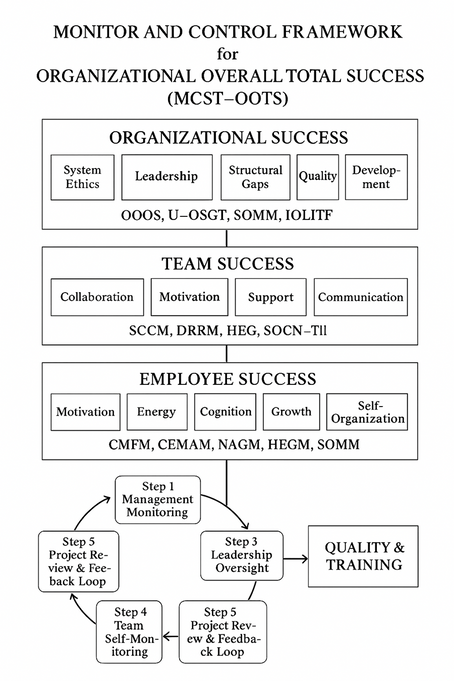🧭 MONITOR AND CONTROL FRAMEWORK for ORGANIZATIONAL OVERALL TOTAL SUCCESS (MCST–OOTS)
- J Jayanthi Chandran

- 6 days ago
- 5 min read
Updated: 3 days ago
🧭 MONITOR AND CONTROL FRAMEWORK FOR ORGANIZATIONAL OVERALL TOTAL SUCCESS (MCST–OOTS)
By J. Jayanthi ChandranOwner, LE MARX ENGINEERING SERVICESAuthor & Researcher in Motivation and Organizational Models
ABSTRACT
The MCST–OOTS (Monitor and Control Framework for Organizational Overall Total Success) proposes a comprehensive, multi-level structure for real-time project control, role differentiation, and organizational success management.The framework integrates monitoring and control theory with Jayanthi Chandran’s original motivational and organizational models — including SCCM, DRRM, HEGM, SOMM, CEMAM, CMFM, and NAGM — unified under the OOTS architecture emphasizing System Ethics, Leadership, Structural Bridging, Quality, Development, and Training.
This integrated system establishes a clear hierarchy of monitoring and control responsibilities among management, managers, leaders, and teams, ensuring balanced project delivery, motivation, quality improvement, and learning cycles aligned with ethical and adaptive organizational success.
1. INTRODUCTION
Modern organizations face complex challenges involving human motivation, team noise, task pressure, and systemic performance deviations.Traditional project control systems focus largely on technical compliance, neglecting behavioral and motivational dynamics.
The MCST–OOTS framework introduces a multi-theoretical integrated approach, combining technical monitoring and human-centered motivation control to ensure consistent organizational, team, and employee success under the OOTS (Organizational Overall Total Success) model.
It is designed for engineering, construction, research, and multidisciplinary organizations requiring continuous monitoring of project deliverables, workforce morale, quality assurance, and adaptive learning.
2. RESEARCH STRUCTURE
3. RESEARCH OBJECTIVES
Define distinct monitoring and control responsibilities for each organizational layer.
Integrate motivation, quality, and training as continuous control variables.
Apply the Eight Motivational & Leadership Pillars (IA, CP, AE, IL, and Performance Plus) across levels.
Build a feedback and learning loop through the CEMAM–CMFM–SOMM–HEGM synergy.
Achieve Organizational Overall Total Success (OOTS) through balanced technical, behavioral, and ethical control.
4. THEORETICAL FOUNDATION
4.1 Core Integration

4.2 The Eight Pillars Integration
5. MODEL STRUCTURE: MCST–OOTS CONTROL CYCLE
6. CONCEPTUAL INTEGRATION MAP
7. COMMUNICATION LOOP: MACCM CYCLE
Monitor → Analyze → Control → Correct → Motivate (MACCM)
Management: Monitor & Analyze
Managers: Control
Leaders: Correct
Team/Self: Motivate
This ensures that unexpressed, underplayed, or behavioral noises within teams are surfaced through constant monitoring, analyzed with cognitive tools, corrected with support and adaptive engagement, and transformed into motivation through feedback.
8. CONTROL DIMENSION MATRIX
9. FEEDBACK, LEARNING, AND IMPROVEMENT CYCLE
Observation: Identify deviations via QA & metrics
Analysis: Apply CEMAM + CMFM to link motivation & cognition
Correction: Use SOMM + AE for adaptive structural correction
Feedback: Employ DRRM + IA for trust and influence realignment
Training Update: Feed into QA-based training improvement
Performance Reinforcement: Use Performance Plus for continuity
10. ROLE OF MIS & MBO
MIS Contribution:
Provides structured, real-time data for each MACCM stage (Monitor–Analyze–Control–Correct–Motivate).
Enhances visibility of behavioral and performance trends.
Integrates motivational metrics (from CEMAM, CMFM) into decision dashboards.
Links communication flow (CP Pillar) with project outcome indicators.
MBO Support:
Translates monitoring results into measurable objectives.
Ensures each level (Management–Manager–Leader–Team) aligns with defined goals.
Promotes adaptive engagement (AE Pillar) to meet dynamic targets.
Reinforces OOTS principle — total success as a shared responsibility.
11. OOTS STRUCTURAL LINKAGE
ORGANIZATIONAL SUCCESS
-------------------------------------------------------------
| System Ethics | Leadership | Structural Gaps | Quality | Development | TRAINING |
| U-OSGT + SOMM | IOLIT + IL | AE + Conceptual-Experiential | QA Metrics | OD + AE | Continuous Learning |
-------------------------------------------------------------
↑
TEAM SUCCESS
-------------------------------------------------------------
| Collaboration | Motivation | Support | Communication | TRAINING |
| SCCM + DRRM + HEG + IA + CP + AE | SOCN–TIEM + Performance Plus |
-------------------------------------------------------------
↑
EMPLOYEE SUCCESS
-------------------------------------------------------------
| Motivation | Energy | Cognition | Growth | Self-Organization |
| CMFM + CEMAM + NAGM + HEGM + SOMM + AE + IL |
-------------------------------------------------------------

12. RESEARCH GAP
13. LIMITATIONS OF RESEARCH
Conceptual and experience-based (non-statistical).
Implementation outcomes depend on organizational culture.
Needs managerial commitment for full application.
No quantitative motivational indices (future scope).
Future research to empirically validate real-time performance linkage.
14. CONTRIBUTIONS TO LITERATURE
15. CONCLUSION
The MCST–OOTS Framework establishes a unified foundation for integrated monitoring, control, and success achievement.By linking motivation, ethics, leadership, quality, and learning through a structured hierarchy, it ensures resilient performance, behavioral balance, and sustainable organizational growth.
This theory advances literature by merging project management and human motivation into one continuous feedback ecosystem — offering a blueprint for Total Organizational Success through real-time adaptive monitoring.




Comments